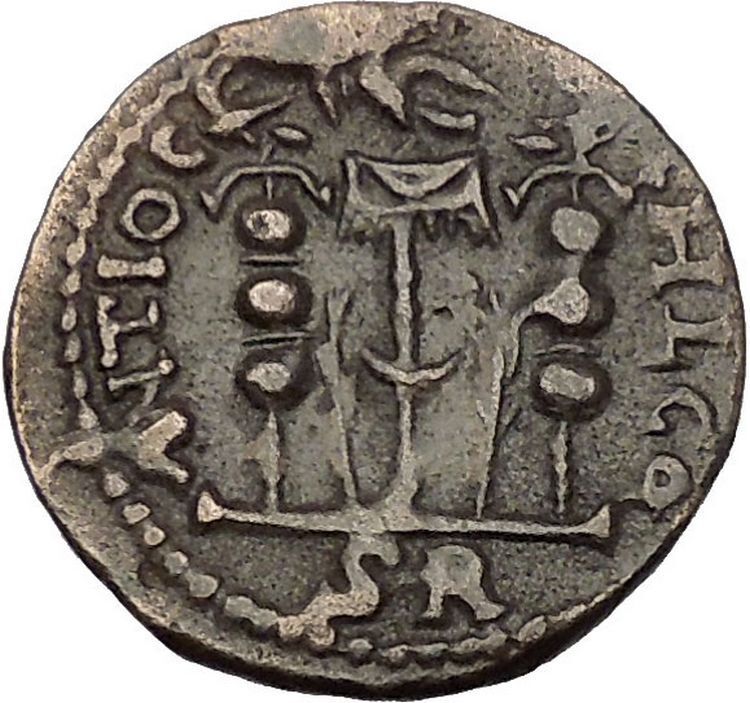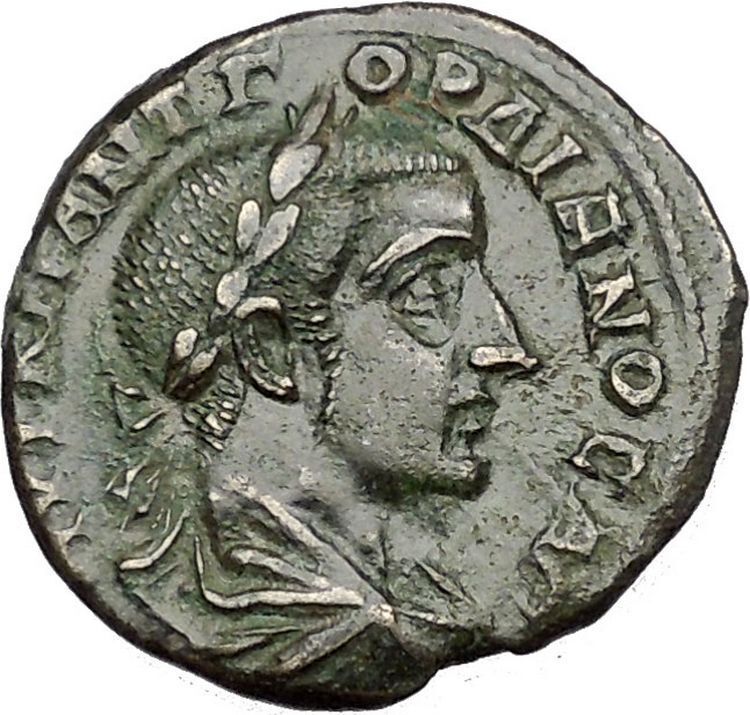|
Diadumenian
–
Roman Caesar
: 218 A.D. –
Bronze 26mm (12.57 grams) of
Nicopolis ad Istrum in Moesia Inferior
under consular legate Marcus Claudius Agrippa
Bare head right.
VΠ AΓPIΠΠA NIKOΠOΛITΩN ΠPOC ICTPΩ,
Tyche standing left, holding patera
and cornucopia. [
You are bidding on the exact item pictured,
provided with a Certificate of Authenticity and Lifetime Guarantee of
Authenticity.
Tyche (Greek for luck; the Roman equivalent was
Fortuna
)
was the presiding
tutelary deity
that governed the fortune and
prosperity of a city, its destiny. Increasingly during the Hellenistic period, cities had their
own specific iconic version of Tyche, wearing a
mural crown
(a crown like the
walls of the city).

The
Greek historian Polybius
believed that when no cause can be
discovered to events such as floods, droughts, frosts or even in politics, then
the cause of these events may be fairly attributed to Tyche.
Stylianos Spyridakis concisely expressed Tyche’s appeal in a
Hellenistic world of arbitrary violence and unmeaning reverses: “In the
turbulent years of the
Epigoni of Alexander
, an awareness of the
instability of human affairs led people to believe that Tyche, the blind
mistress of Fortune, governed mankind with an inconstancy which explained the
vicissitudes of the time.”
In literature, she might be given various genealogies, as a daughter of
Hermes
and
Aphrodite
, or considered as one of the
Oceanids
, daughters of
Oceanus
and
Tethys
, or of
Zeus. She was connected with
Nemesis
and
Agathos Daimon
(“good spirit”).
She was uniquely venerated at
Itanos
in Crete, as Tyche Protogeneia,
linked with the Athenian
Protogeneia
(“firstborn”), daughter of
Erechtheus
, whose self-sacrifice saved the
city.
She had temples at
Caesarea Maritima
,
Antioch
,
Alexandria
and
Constantinople
. In
Alexandria
the Tychaeon, the temple of
Tyche, was described by
Libanius
as one of the most magnificent of the
entire Hellenistic world.
Tyche appears on many
coins
of the Hellenistic period in the three
centuries before the Christian era, especially from cities in the Aegean.
Unpredictable turns of fortune drive the complicated plotlines of
Hellenistic romances
, such as
Leucippe and Clitophon
or
Daphnis and Chloe
. She experienced a
resurgence in another era of uneasy change, the final days of publicly
sanctioned
Paganism
, between the late-fourth-century
emperors
Julian
and
Theodosius I
who definitively closed the
temples. The effectiveness of her capricious power even achieved respectability
in philosophical circles during that generation, though among poets it was a
commonplace to revile her for a fickle harlot.
In medieval art
, she was depicted as carrying a
cornucopia
, an
emblematic
ship’s rudder, and the
wheel of fortune
, or she may stand on the
wheel, presiding over the entire circle of fate.
The constellation of
Virgo
is sometimes identified as the heavenly
figure of Tyche, as well as other goddesses such as
Demeter
and
Astraea
.
Nicopolis ad Istrum was a
Roman
and Early
Byzantine
town founded by Emperor
Trajan
around 101–106, at the junction of the
Iatrus (Yantra)
and the Rositsa
rivers, in memory of his victory over
the Dacians
. Its ruins are located at the village
of
Nikyup
, 20 km north of
Veliko Tarnovo
in northern
Bulgaria
. The town reached its apogee during
the reigns of Trajan,
Hadrian
, the
Antonines
and the
Severan dynasty
.

The classical town was planned according to the orthogonal system. The
network of streets, the forum surrounded by an Ionic colonnade and many
buildings, a two-nave room later turned into a basilica and other public
buildings have been uncovered. The rich architectures and sculptures show a
similarity with those of the ancient towns in Asia Minor. Nicopolis ad Istrum
had issued coins, bearing images of its own public buildings.
In
447 AD
, the town was destroyed by
Attila’s
Huns. Perhaps it was already abandoned before the early 400s. In the
6th century, it was rebuilt as a powerful fortress enclosing little more than
military buildings and churches, following a very common trend for the cities of
that century in the Danube area.The largest area of the extensive ruins (21.55
hectares) of the classical Nicopolis was not reoccupied since the fort covered
only one fourth of it (5.75 hectares), in the southeastern corner. The town
became an episcopal centre during the early Byzantine period. It was finally
destroyed by the Avar invasions at the end of the 6th century. A Bulgarian
medieval settlement arose upon its ruins later (10th-14th century).
Nicopolis ad Istrum can be said to have been the birthplace of
Germanic
literary tradition. In the 4th
century, the Gothic
bishop, missionary and translator
Ulfilas
(Wulfila) obtained permission from
Emperor
Constantius II
to immigrate with his flock of
converts to Moesia and settle near Nicopolis ad Istrum in 347-8. There, he
invented the
Gothic alphabet
and translated the
Bible
from
Greek
to
Gothic
.
Marcus Opellius Antoninus Diadumenianus or Diadumenian
(208–218) was the son of the Roman Emperor Macrinus, and served his father
briefly as Caesar (May 217–218) and as Augustus (in 218). Diadumenian was born
in 14th of September 208 a.C or according to Historia Augusta in 19th of
September 208 a.C because he shared the same birthday with the emperor Antoninus
Pius. His mother was Empress Nonia Celsa, although her existence remains
dubious, because she was only mentioned by the Historia Augusta. He was born
Marcus Opellius Diadumenianus, but his name was changed and added Antoninus to
solidify connection to the family of Marcus Aurelius as done by Caracalla.
Diadumenian had little time to enjoy his position or to learn anything from its
opportunities because the legions of Syria revolted and declared Elagabalus
ruler of the Roman Empire. When Macrinus was defeated on June 8, 218, at
Antioch, Diadumenian followed his father’s death.
|










